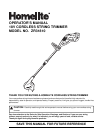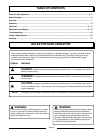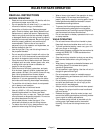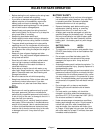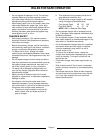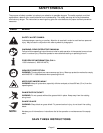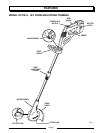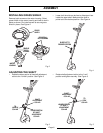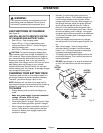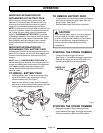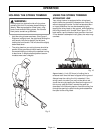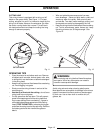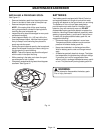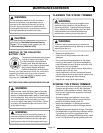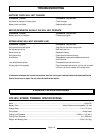
Page 4
• Before starting the unit, make sure the string head
will not come in contact with anything.
• If you strike or become entangled with foreign
objects, stop the unit immediately, remove the
battery pack and check for damage. Do not
operate before repairing damage. Do not operate
the unit with loose or damaged parts.
• Keep all body parts away from string head and
other moving parts. Do not touch or try to stop the
string head when it is rotating.
• Keep string head below waist level.
• Always stop the motor when cutting is delayed or
when walking from one cutting location to another.
• The grass shield must always be in place while
operating the unit. Do not operate unit without the
cutting line extended, and the proper line installed.
Do not extend the cutting line beyond the length of
the shield.
• Keep unit clean of grass clippings and other
materials. They may become lodged between the
string head and shield.
• Store the unit inside in a dry place, either locked
up or up high to prevent unauthorized use or
damage. Keep out of the reach of children or
untrained individuals.
• Never douse or squirt the unit with water or any
other liquid. Keep handles dry, clean and free from
debris. Clean after each use, see Cleaning and
Storage instructions.
• Be sure to secure the unit while transporting.
• Keep these instructions. Refer to them often and
use them to instruct other users. If you loan
someone this unit, also loan them these instruc-
tions.
SERVICE
• Service on unit must be performed only by quali-
fied repair personnel. Service or maintenance
performed by unqualified personnel could result in
a risk of injury to the user, or damage to the unit. It
may also void your warranty.
• When servicing a unit, use only identical replace-
ment parts. Follow instruction in the Maintenance
section of this manual. Use of unauthorized parts
or failure to follow Maintenance Instructions may
create a risk of shock or serious injury to the user,
or damage to the unit. It may also void your
warranty.
RULES FOR SAFE OPERATION
BATTERY SAFETY
• Battery operated units do not have to be plugged
into an electrical outlet; therefore, they are always
in operating condition. Be aware of possible
hazards even when unit is not operating.
• Remove the battery pack before making any
adjustments, cleaning, storing, or removing
material from the unit, or when not in use.
• A battery pack must be recharged only with the
specified charger for the battery pack. A charger
that may be suitable for one type of battery pack
may create a risk of fire when used with another
battery pack. Use battery pack only with charger
listed.
BATTERY PACK: 1323701
CHARGER: 1425701
• To reduce the risk of explosion and possible injury,
DO NOT place battery units or their batteries near
fire or heat.
• Do not open or mutilate the battery pack. Re-
leased electrolyte is corrosive and may cause
damage to the eyes or skin. It may be toxic if
swallowed.
• A damaged battery pack is subject to explosion. To
avoid serious personal injury, properly dispose of a
damaged battery pack.
• Batteries vent hydrogen gas and can explode in the
presence of a source of ignition, such as a pilot light.
To reduce the risk of serious personal injury, never
use any cordless product in the presence of open
flame. An exploded battery pack can propel debris
and chemicals. If exposed, flush with water immedi-
ately.
• Do not charge unit in a damp or wet location.
Following this rule will reduce the risk of electric
shock.
• For best results, your battery unit should be
charged in a location where the temperature is
more than 50°F (10°C) but less than 100°F (38°C).
Do not store outside or in vehicles.
• Under extreme usage or temperature conditions,
battery pack leakage may occur. If liquid comes in
contact with your skin, wash immediately with
soap and water, then neutralize with lemon juice
or vinegar. If liquid gets into your eyes, flush them
with clean water for at least 10 minutes, then seek
immediate medical attention.



